Ethereum experienced a significant drop due to tariff impacts and market deleveraging, but rebounded with the support of diplomatic negotiations, institutional buying, and network upgrades. The future trend depends on L2 development, market adoption, and the macroeconomic environment. However, this article optimistically predicts that it could reach $7,000 by 2025 and as high as $47,000 by 2030.
Author: Ankish Jain
Translation: Blockchain in Plain Language

A fierce sell-off cleared out weak ETH positions in the market, followed by a significant rebound. With new tariffs, whale movements, and network upgrades underway, is Ethereum gearing up for a bull market in 2025?
Table of Contents
Diplomatic negotiations trigger ETH rebound
Ethereum ecosystem updates
Can Ethereum stabilize?
Ethereum price prediction: Will the downtrend reverse?
1. Diplomatic negotiations trigger ETH rebound
Ethereum (ETH) price movements In the past few days, Ethereum's price has experienced extreme volatility, dropping to $2,150 on February 3, marking the lowest level since September 2024. This decline was primarily influenced by the financial market's reaction to the new U.S. tariff policy, which officially took effect on February 1.
Tariff impacts create market uncertainty The U.S. government imposed a 25% tariff on imports from Canada and Mexico and a 10% tariff on Chinese goods, quickly causing unrest in global markets, with the crypto market not spared.
Diplomatic intervention stabilizes market sentiment However, within hours, diplomatic efforts were swiftly initiated. Canadian Prime Minister Justin Trudeau announced on X (formerly Twitter) that he had spoken with Donald Trump and successfully negotiated a 30-day tariff suspension to allow both countries to discuss a broader border security agreement. This news provided a brief respite for the market, and Ethereum's price began to stabilize and rise.
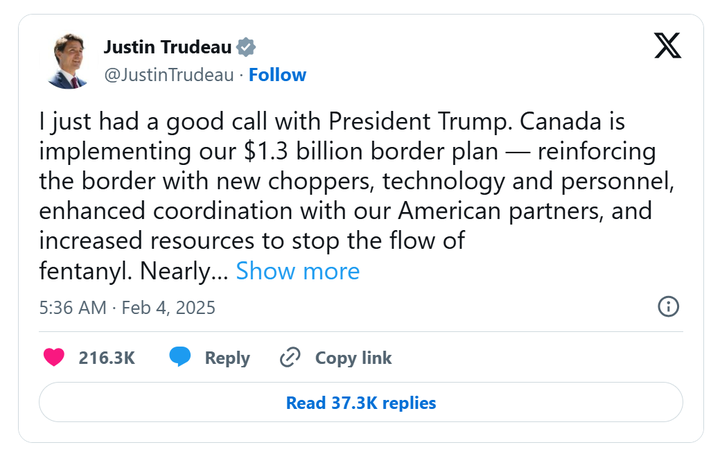
Mexico also adopted a similar response strategy, with President Claudia Sheinbaum confirming that the tariffs would be suspended for one month as part of the border security discussions.Market sentiment improves, ETH price rebounds
Driven by these diplomatic developments, market sentiment improved. As of February 4, the ETH price had risen to $2,700.ETH briefly touched $2,900, Trump family speaks out
After Trump announced the suspension of tariffs on Canada and Mexico, the ETH price briefly reached $2,900. Almost simultaneously, Eric Trump posted on X:
“In my opinion, now is a great time to increase holdings of $ETH.”This statement further boosted positive market sentiment.
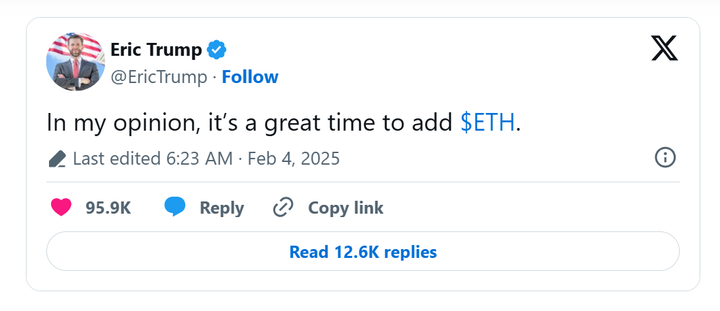
Trump family's DeFi-related project large transfer draws market attentionEric Trump's comments coincided with World Liberty Financial (WLFI) conducting a large-scale fund transfer. This DeFi project is closely related to Donald Trump, Donald Trump Jr., and Eric Trump.
According to data, WLFI transferred $3.0741 million worth of eight assets to Coinbase Prime for financial management. This move drew market attention and could further influence market sentiment for digital assets like Ethereum.
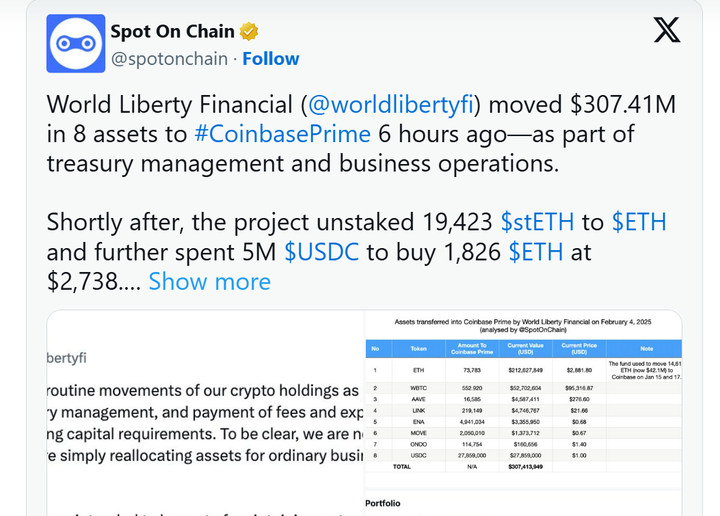
https://x.com/spotonchain/status/1886572108324725075?ref_src=twsrc%5Etfw%7Ctwcamp%5Etweetembed%7Ctwterm%5E1886572108324725075%7Ctwgr%5Ef39d77470064a7d15d206e3daa158fa4b431af84%7Ctwcon%5Es1_&ref_url=https%3A%2F%2Fcrypto.news%2Fethereum-price-prediction-2025-2030-outlook%2F- WLFI unstakes Lido and heavily buys ETH
Shortly after, World Liberty Financial (WLFI) unstaked 19,423 Lido staked Ethereum (stETH) and converted it to ETH. Subsequently, the project used $5 million USDC to purchase 1,826 ETH at a price of $2,738.
Currently, WLFI still holds $9.662 million in various assets across nine known wallets, indicating that the project is actively managing its crypto asset allocation.
While WLFI was making moves, traditional financial giant Fidelity also made a notable move—on February 4, the institution purchased $49.75 million worth of ETH.
This series of fund movements shows that Ethereum not only rebounded strongly after market turbulence but also attracted firm buying from institutional investors, further boosting market confidence.
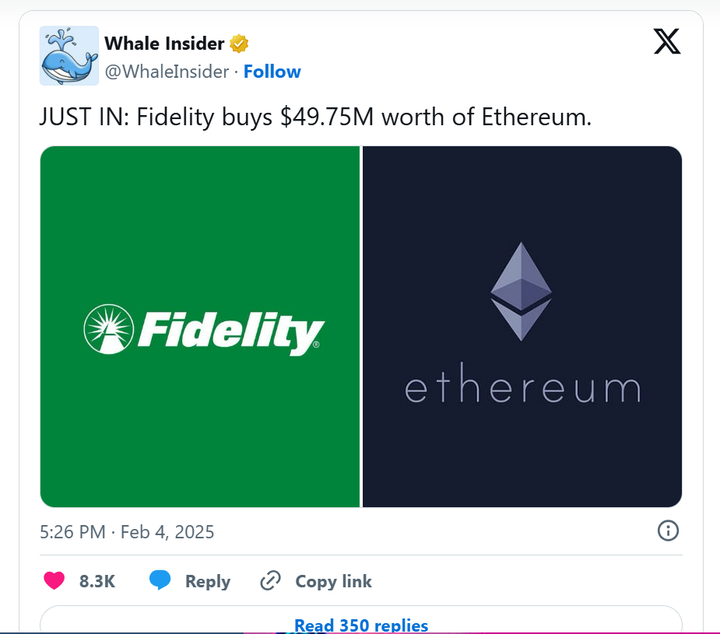
Despite the increase in institutional investment and price rebound, Ethereum still fell 15% over the past week, and is nearly 45% below its historical high of $4,890 (November 2021).So, what exactly is happening in the Ethereum ecosystem? How will these changes affect ETH's future price trends? Let’s delve deeper.
- Ethereum ecosystem updates
Ethereum is undergoing critical adjustments to enhance scalability and optimize transaction efficiency.
Gas limit increase and scalability improvements
On February 3, Ethereum validators first passed a proposal to increase the gas limit, marking the first adjustment since the Merge, signifying another step forward in network scalability.Adjustment details:
Gas limit increased from 30 million to 31 million, with potential further increases to 36 million in the future.
Unlike previous changes that required a hard fork, this adjustment is automatically effective and implemented immediately after over 50% of validators expressed support.
Importance of the gas mechanism: Gas represents the computational power required to execute transactions and smart contracts; each operation consumes gas fees, and the gas limit determines the total computational capacity a single block can accommodate.When transaction volume exceeds the limit, users must either wait for subsequent blocks or pay higher fees to prioritize their transactions.
Increasing the gas limit means more transactions can fit into a single block, improving network throughput and alleviating congestion.
Impacts and challenges:Helps complex DeFi applications, NFT platforms, and on-chain services run more smoothly.
However, the gas limit adjustment does not address the core issues—transaction costs and speed.
Ethereum processes 1-1.5 million transactions daily, while Solana processes 60-65 million, demonstrating far superior efficiency and lower transaction costs.
This indicates that Ethereum's long-term scalability challenges remain, and L2 solutions and protocol upgrades are still crucial. With the increase in gas limits and upcoming upgrades, can Ethereum narrow the gap with competitors and lay the groundwork for the market conditions in 2025? The future development of the network remains worth close attention.
- Ethereum's market position and competitive challenges
To address scalability and competitive pressure, Ethereum plans to launch the Pectra upgrade in early 2025, which is expected to significantly enhance the scalability of L2 solutions.
1) Key improvements in Pectra: Increase in Blob targets
- The Pectra upgrade will increase the Blob targets from 3 to 6.
- Blob (large data packets) is a mechanism used by L2 solutions for temporarily storing transaction data, avoiding direct writes to the Ethereum main chain.
- The increase in Blob capacity can boost the throughput of L2 networks, making transactions faster and cheaper.
2) Continuous expansion of the Layer-2 ecosystem
Currently, Arbitrum, Optimism, and zkSync have become important cornerstones for Ethereum's scalability:
- Arbitrum is the L2 solution with the highest TVL, significantly reducing costs by batching Ethereum transactions and generating compressed proofs.
- Optimism employs a similar approach but additionally introduces incentive mechanisms to encourage developers to build applications on its network through OP Tokens, enhancing ecosystem vitality.
With the advancement of the Pectra upgrade, Ethereum's L2 ecosystem will welcome more efficient transaction processing capabilities, further strengthening its advantage in the scalability competition. However, in the face of competition from efficient and low-cost public chains like Solana, Ethereum's market position still relies on continuously optimizing the L2 ecosystem and reducing user costs to solidify its standing.
After these upgrades are implemented, whether Ethereum can dominate the 2025 bull market remains to be seen.
3) zkSync: Zero-knowledge Rollup offers more advanced scalability solutions
zkSync utilizes zero-knowledge Rollup (zk-Rollup) to provide more advanced scalability solutions, enabling near-instant transactions while reducing fees.
While L2 solutions have played a crucial role in alleviating Ethereum's congestion issues, they also highlight the core differences between Ethereum and its competitors.
4) Ethereum vs. competing public chains: Fundamental differences in scalability approaches
- Ethereum relies on Layer-2 solutions to enhance scalability, while public chains like Solana, Avalanche, and Sei natively support high throughput without the need for additional scaling layers.
- Solana: Can process tens of thousands of transactions per second without L2, at extremely low costs.
- Avalanche: Uses a subnet mechanism to improve scalability and supports custom blockchain deployments.
- Sei: An emerging high-performance chain focused on decentralized finance (DeFi) scenarios, featuring extremely fast transaction speeds. In contrast, Ethereum still faces scalability challenges, relying on L2 scaling, while the underlying architecture of competing public chains is already capable of efficiently processing large volumes of transactions, putting greater competitive pressure on Ethereum regarding scalability.
5) ETH/BTC trend under pressure, Ethereum's market position challenged
In addition to technical competition, Ethereum's market performance is also affected.
- As of February 4, the ETH/BTC trading pair fell to 0.027, marking the lowest level since March 2021.
- This ratio has dropped nearly 50% compared to a year ago, indicating that ETH is in a relatively weak position compared to BTC, with market funds possibly leaning more towards Bitcoin or other competing public chains. In the face of technical upgrades and market position challenges, Ethereum's future competitiveness depends not only on the development of the L2 ecosystem but also on reducing transaction costs and improving mainnet performance. Otherwise, it may further lose its advantage in the 2025 market competition.
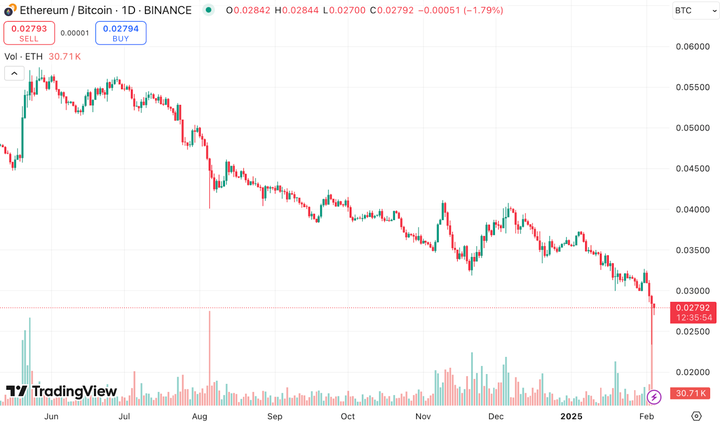
6) Bitcoin dominates market liquidity, Ethereum's valuation under pressure
As Bitcoin continues to rise in market liquidity and investor attention, Ethereum's relative valuation remains under close observation.
7) Can Ethereum stabilize?
ETH dropped to $2,150: Market deleveraging clears excessive speculation Ethereum fell to $2,150 on February 3, influenced not only by macroeconomic uncertainty but also as a market deleveraging adjustment that cleared out over-leveraged long positions.
Analyst @EmperorBTC pointed out,
“There are a lot of low-quality ETH leveraged long positions in the market, which were liquidated when the price hit the $2,100 area.”
Data shows that Ethereum's Open Interest decreased by $4 billion in a short period, which helped the market stabilize to some extent.
🔗 Related tweet: https://x.com/EmperorBTC/status/1886484757627744742
After deleveraging, spot demand drives ETH rebound
- After the clearing of leverage, Ethereum rebounded from $2,150 to $2,700, primarily driven by spot demand rather than leverage, indicating a healthier market foundation.
- The support from spot buying means that market sentiment has somewhat recovered, laying a more solid foundation for ETH's future price trends.
- Technical analysis: Ethereum tests key support levels
ETH briefly fell below the 200-week moving average (200 WMA), a technical indicator that has long been an important support area.
Another trader pointed out that ETH touched the 0.618 Fibonacci retracement level, which is typically a key support level at market cycle bottoms.
“ETH may have delivered the best 'gift' of 2025, breaking below the 200 WMA and testing the 0.618 Fibonacci retracement in the early morning.”
This technical pattern suggests that ETH may have entered a phase bottom area, and if market demand continues to rise, subsequent prices may rebound further.
However, ETH still needs to prove its competitiveness against BTC while relying on the Pectra upgrade and the advancement of the L2 ecosystem to enhance its market position.

1) ETH price rebounds to 200 WMA, but macro environment still poses risks
Although ETH price has regained the 200-week moving average (200 WMA), historical data shows that Ethereum experienced a strong rebound after testing this support level in August and September 2024.
However, the macroeconomic environment remains full of uncertainty:
- The trigger for the market crash — the escalation of U.S. tariffs — has caused volatility in global financial markets.
- Diplomatic negotiations have temporarily eased market pressure, but potential retaliatory measures or further economic restrictions may still pose risks to market sentiment.
- If global liquidity tightens or market risk appetite declines, Ethereum's recovery momentum may face challenges.
2) ETH/BTC trend: Is market capital leaning more towards Bitcoin?
- ETH/BTC continues to decline, indicating that market capital favors Bitcoin, especially with institutional investors showing a clear preference for BTC.
- The Ethereum Pectra upgrade and Gas limit increases may drive ecosystem growth, but whether these improvements can truly bring tangible benefits to users and developers will ultimately determine ETH's long-term demand.
- Ethereum price prediction: Will the downtrend reverse?
This market adjustment has cleared billions of dollars in leveraged positions, placing ETH in a healthier market environment, but future price trends remain influenced by multiple factors: scalability upgrades (Pectra, L2 development), market adoption rates (DeFi, NFT ecosystem growth), competitive landscape (challenges from public chains like Solana, Avalanche), and macroeconomic environment (interest rates, liquidity changes).
1) Ethereum price prediction for 2025
🔹 DigitalCoinPrice predicts: ETH average price $5,510, highest $6,037
🔹 Changelly is more optimistic: ETH average $6,124, highest $7,194
DeAgentAI co-founder Joe believes that Ethereum's current price trend aligns with historical patterns, noting that short-term bearish signals (like the February 3 drop below the 200 WMA) often require more detailed interpretation.
He points out that historical trends from 2023 and 2024 show that near key support levels, ETH may experience a sharp reversal, so traders should pay attention to ETH's response to key support as an important signal for judging future trends.
Can Ethereum usher in a bull market in 2025?
ETH is currently in a recovery rebound phase, and if the Pectra upgrade is successfully implemented, along with the continuous expansion of the L2 ecosystem, Ethereum is expected to regain market attention and close the market share gap with Bitcoin. However, if macroeconomic turmoil persists or competing public chains further erode Ethereum's market share, ETH's gains may be limited.
2) Ethereum price prediction for 2027
If Ethereum continues to dominate the smart contract space and scalability solutions mature, ETH may see an increase in 2027.
- DigitalCoinPrice predicts: ETH average price $9,580, highest $10,098.
- Changelly predicts: ETH average $12,316, highest $14,527. At the same time, growth in the DeFi ecosystem, innovations in the NFT space, and Ethereum's role in the tokenization of real-world assets (RWA) may bring new demand for ETH.
However, if risk assets face tightening conditions, ETH prices may encounter resistance, even if the fundamentals improve.
3) Ethereum price prediction for 2030
Long-term predictions indicate that Ethereum may reach price levels that were previously unimaginable.
- DigitalCoinPrice predicts: ETH average price $14,829, highest $15,108.
- Changelly predicts: ETH average $40,055, highest $47,066. However, long-term predictions always come with risks. Ethereum faces competition from Solana, Avalanche, and emerging blockchain networks that are committed to providing lower fees and higher transaction speeds.
Despite the optimistic ETH prediction models, it is crucial to combine technical forecasts with real-world adoption trends before making long-term investment decisions. Therefore, investments should be made cautiously, and one should not invest more than they can afford to lose.
Article link: https://www.hellobtc.com/kp/du/02/5660.html
Source: https://crypto.news/ethereum-price-prediction-2025-2030-outlook/
免责声明:本文章仅代表作者个人观点,不代表本平台的立场和观点。本文章仅供信息分享,不构成对任何人的任何投资建议。用户与作者之间的任何争议,与本平台无关。如网页中刊载的文章或图片涉及侵权,请提供相关的权利证明和身份证明发送邮件到support@aicoin.com,本平台相关工作人员将会进行核查。




